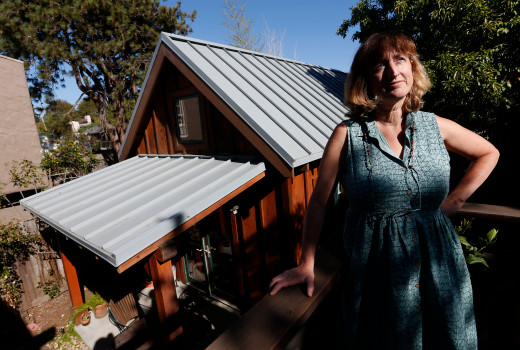|
| State unveils new laws aimed at dealing with housing shortage
Will make it easier for cities to approve accessory dwelling units

Karen Chapple is photographed on her deck overlooking her accessory dwelling unit at her home in Berkeley, Calif., on Tuesday, July 12, 2016. A series of new laws aim to make it easier for homeowners to build such units by avoiding separate utility metering and other previous restrictions. (Jane Tyska/Bay Area News Group)
By Karina Ioffee | kioffee@bayareanewsgroup.com
PUBLISHED: December 16, 2016 at 12:27 pm | UPDATED: December 16, 2016 at 2:24 pm
RICHMOND — Local and state officials on Friday highlighted a set of new laws aimed at helping ease California’s affordable housing crisis, including legislation that will allow owners of single-family homes to convert a portion of their home to a separate unit that can be rented out without going through expensive upgrades.
Accessory dwelling units, such as a master bedroom converted to a separate living unit with its own outside door, or a former garage that can now be rented as a studio, are a way to help ease the shortage of housing and give cities flexibility when it comes to creating new structures, housing officials and local politicians said, speaking at a news conference at Richmond’s City Hall.
“It instantly creates an opportunity to expand the supply of housing at low rent levels,” said Richmond Mayor Tom Butt. “Everything else we try to do to impact lack of housing takes years. This is something you could do in a weekend.”
Richmond was one of the first cities in California to pass a junior accessory dwelling unit ordinance, which also went into effect this week. Previously, homeowners who tried to convert a portion of their residence into a separate living unit were often stymied by requirements that the units have their own sewer and electricity meters, Butt said. Separate fire sprinkler systems will also not be required if the main house does not have them. Units can vary between 150 and 500 square feet and have partial kitchens and bathrooms.
Mayor Butt was joined at Friday’s news conference by Assemblyman Tony Thurmond, D-Richmond, California Housing and Community Development Director Ben Metcalf and Rachel Ginis, the executive director of Lilypad Homes, a nonprofit organization that helped sponsor legislation on accessory dwelling units.
“The way we are living in our homes is changing as more and more people are combining their resources to stay in their home and turning their home as a resource to generate additional income,” Ginis said. “In-law apartments are the hottest amenity in the real estate market right now.”
Over the past 50 years, home sizes have increased by more than 30 percent, while households have actually decreased, to an average of just 2.3 people, according to Thurmond. Today, only one-third of the state’s population has two adults and a child living in a home. Instead, the majority of households are single-parent families, couples without children, empty nesters and young professionals.
The new laws surrounding accessory dwelling units include AB 2406, AB 59 and AB 45. |
|

